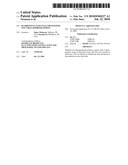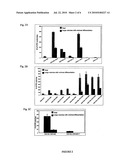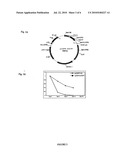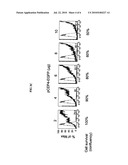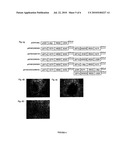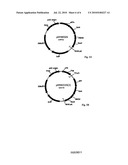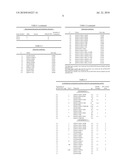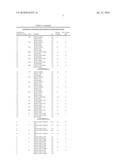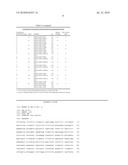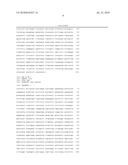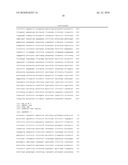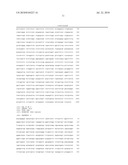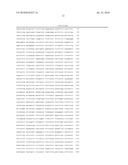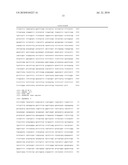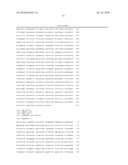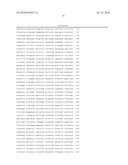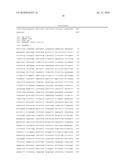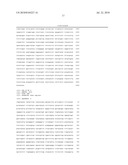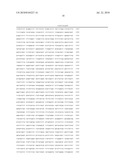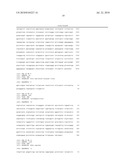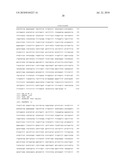Patent application title: PLURIPOTENT STEM CELLS OBTAINED BY NON-VIRAL REPROGRAMMING
Inventors:
James Thomson (Madison, WI, US)
James Thomson (Madison, WI, US)
Junying Yu (Middleton, WI, US)
IPC8 Class: AC12N1563FI
USPC Class:
435455
Class name: Chemistry: molecular biology and microbiology process of mutation, cell fusion, or genetic modification introduction of a polynucleotide molecule into or rearrangement of nucleic acid within an animal cell
Publication date: 2010-07-22
Patent application number: 20100184227
Claims:
1. A method of reprogramming primate somatic cells, the method comprising
the steps of:exposing the primate somatic cells to a plurality of
potency-determining factors under conditions sufficient to reprogram the
cells; andculturing the exposed cells to obtain reprogrammed cells having
a higher potency level than the primate somatic cells, the reprogrammed
cells being substantially free of any component associated with exposing
the potency-determining factors to the somatic cells.
2. The method of claim 1, wherein the primate somatic cells are obtained from a fetal or post-natal individual.
3. The method of claim 1, wherein the primate is a human.
4. The method of claim 1, wherein the reprogrammed cells are genetically identical to a fetal or post-natal individual.
5. The method of claim 1, wherein the exposing step includes the step of introducing at least one vector encoding one or more potency-determining factors into the primate somatic cells.
6. The method of claim 5, wherein the vector is a non-viral episomal vector.
7. The method of claim 5, wherein the one or more potency-determining factors comprise human OCT-4, human SOX2, human LIN28, human NANOG, human c-Myc, and human KLF4, wherein when the vector comprises c-Myc, the method further comprises the step of exposing the primate somatic cells to SV40 T Antigen.
8. The method of claim 5, wherein the at least one vector is a single vector.
9. The method of claim, wherein the single vector comprises at least one internal ribosomal entry site.
10. The method of claim 8, wherein the single vector comprises, in order, a first promoter, OCT4, IRES2, SOX2, a second promoter, SV40 T antigen, IRES2, and KLF4.
11. The method of claim 8, wherein the vector comprises, in order, a first promoter, OCT4, IRES2, SOX2, a second promoter, c-Myc, IRES 2, KLF4, a third promoter, NANOG, IRES2, and LN28.
12. The method of claim 5, wherein a first vector comprises, in order, a first promoter, OCT4, IRES2, SOX2, a second promoter, SV40 T antigen, IRES2, and KLF4, wherein a second vector comprises, in order, a third promoter, OCT4, IRES2, SOX2, a fourth promoter, NANOG, IRES2, and KLF4, and wherein a third vector comprises, in order, a fifth promoter, c-Myc, IRES 2, and LN28, wherein the promoters need not be identical.
13. The method of claim 12, wherein each of the first, second, third, and fourth promoters is an elongation factor 1.alpha. (EF1.alpha.) gene promoter.
14. The method of claim 5, wherein a first vector comprises, in order, a first promoter, OCT4, IRES2, SOX2, a second promoter, KLF4, IRES2, c-Myc, a third promoter, NANOG, IRES2, and LN28, wherein a second vector comprises, in order, a fourth promoter, OCT4, IRES2, SOX2, a fifth promoter, SV40 T antigen, IRES2, and KLF4, wherein the promoters need not be identical.
15. The method of claim 14, wherein each of the first, third, fourth, and fifth promoters is an EF1.alpha. gene promoter and wherein the second promoter is a cytomegalovirus immediate early gene (CMV) promoter.
16. The method of claim 5, wherein a first vector comprises, in order, a first promoter, OCT4, IRES2, SOX2, a second promoter, NANOG, IRES2, and LN28, wherein a second vector comprises, in order, a third promoter, OCT4, IRES2, SOX2, a fourth promoter, SV40 T antigen, IRES2, and KLF4, and wherein a third vector comprises, in order, a fifth promoter, OCT4, IRES2, SOX2, a sixth promoter, c-Myc, IRES 2, and KLF4, wherein the promoters need not be identical.
17. An enriched population of primate pluripotent cells produced according to a method comprising the step ofexposing primate somatic cells to a plurality of potency-determining factors under conditions sufficient to express the potency-determining factors, thereby reprogramming the somatic cells to produce the primate pluripotent cells;the cells being substantially free of any component associated with exposing the potency-determining factors to the somatic cells.
18. The population of claim 17, wherein the primate somatic cells are obtained from a fetal or post-natal individual.
19. The population of claim 17, wherein the primate is a human.
20. The population of claim 17, wherein the pluripotent cells are substantially genetically identical to a post-natal individual.
21. The population of claim 17, wherein the exposing step includes the step of introducing at least one vector encoding one or more potency-determining factors into the primate somatic cells.
22. The population of claim 21, wherein the vector is a non-viral episomal vector.
23. The population of claim 21, wherein the one or more potency-determining factors comprise human OCT-4, human SOX2, human LIN28, human NANOG, human c-Myc, and human KLF4, wherein when the vector comprises c-Myc, the method further comprises the step of exposing the primate somatic cells to SV40 T Antigen.
24. Primate induced pluripotent cells substantially free of any component associated with induction of pluripotency.
Description:
CROSS-REFERENCE TO RELATED APPLICATION
[0001]This application claims the benefit of U.S. Provisional Patent Application No. 61/108,362, filed Oct. 24, 2008, incorporated herein by reference as if set forth in its entirety.
BACKGROUND
[0003]Embryonic stem (ES) cells hold great promise in science and medicine due to their pluripotent nature, i.e. the ability to replicate indefinitely and differentiate into cells of all three germ layers (Thomson et al., Science 282:1145-1147 (1998), incorporated by reference herein as if set forth in its entirety). The application of human ES cells in therapy and regenerative medicine is complicated by the possibility of rejection by the recipient's immune system. Human pluripotent cells that are substantially genetically identical to a particular recipient are, thus, highly desirable. Also, genetic identity may be important for the use of ES cells in designing patient-specific treatment strategies.
[0004]First attempts to generate pluripotent cells from a post-natal primate individual employed somatic nuclear transfer (see, e.g., Byrne, JA et al., Nature 450:497-502 (2007)) and cell fusion (see, e.g., Yu, J et al., Stem Cells 24:168-176 (2006)). However, clinical use of somatic nuclear transfer is impractical due to its low efficiency, while cell fusion results in near tetraploid cells. In 2007, two groups of scientists reprogrammed somatic cells from a post-natal primate individual into pluripotent stem cells (Yu et al. Science 318:1917-1920 (2007) and Takahashi et al., Cell 131:861-872 (2007)), each incorporated by reference herein as if set forth in its entirety. Both groups delivered into, and expressed in, human somatic cells cDNA of four transcription factors using a viral vector system for expressing potency-determining transgenes. The transcription factors of Takahashi et al. were OCT4, SOX2, c-Myc, and KLF4, while Yu et al. employed OCT4, SOX2, NANOG, and LIN28. The expression of these sets of transcription factors induced human somatic cells to acquire ES cell-specific characteristics, including morphology, proliferation, and gene- and surface marker expression. Somatic cells reprogrammed in this manner are referred to as induced pluripotent (iPS) cells. The existence of iPS cells circumvents the need for blastocysts and reduces concerns associated with immune rejection.
[0005]Shortly thereafter, Lowry et al. generated patient-specific iPS cell lines through ectopic expression of OCT4, SOX2, c-Myc, and KLF4 (Lowry et al., PNAS105:2883-2888 (2008)) transgenes. More recently, iPS cells have been generated from a number of different human and murine somatic cell types, such as epithelial, fibroblast, liver, stomach, neural, and pancreatic cells. Further, iPS cells have been successfully differentiated into cells of various lineages (e.g., Dimos et al. Science 321:1218-1221 (2008)).
[0006]Current methods for generating iPS cells employ retroviral vectors such as those derived from lentivirus. These vectors stably integrate into, and permanently change, a target cell's DNA at virtually any chromosomal locus. This untargeted interaction between reprogramming vector and genome is associated with a risk of aberrant cellular gene expression as well as neoplastic growth caused by viral gene reactivation (Okita et al. Nature 448:313-317 (2007)).
[0007]Moreover, continued presence and expression of the transgenes can interfere with the recipient cell's physiology. Further, ectopic expression of transcription factors used to reprogram somatic cells, such as c-Myc, can induce programmed cell death (apoptosis) (Askew et al., Oncogene 6:1915-1922 (1991), Evan et al., Cell 69:119-128 (1992)). Furthermore, continued expression of factors such as OCT4 can interfere with subsequent differentiation of iPS cells.
[0008]It is desirable to reprogram somatic cells to a state of higher potency without altering the cells' genetic makeup beyond the reprogramming-associated alterations. Recently, Stadtfeld et al. generated murine iPS cells using a nonintegrating adenovirus that transiently expressed OCT4, SOX2, KLF4, and c-Myc (Stadtfeld et al., Sciencexpress, Sep. 25, 2008). To date, primate iPS cells generated without using retroviral vectors have not been reported.
BRIEF SUMMARY
[0009]The present invention is broadly summarized as relating to reprogramming of differentiated primate somatic cells to produce primate pluripotent cells.
[0010]In a first aspect, the invention is summarized in that a method for producing a primate pluripotent cell includes the step of delivering into a primate somatic cell a set of transgenes sufficient to reprogram the somatic cell to a pluripotent state, the transgenes being carried on at least one episomal vector that does not encode an infectious virus, and recovering pluripotent cells. References herein to a "non-viral" vector or construct indicate that the vector or construct cannot encode an infectious virus.
[0011]In a second aspect, the invention relates to an enriched population of replenishable reprogrammed pluripotent cells of a primate, including a human primate, wherein, in contrast to existing iPS cells, the at least one vector, including any element thereof having a viral source or derivation is substantially absent from the pluripotent cells. As used herein, this means that the reprogrammed cells contain fewer than one copy of the episomal vector per cell, and preferably no residual episomal vector in the cells. Because asymmetric partitioning during cell division dilutes the vector, one can readily obtain reprogrammed cells from which the vector has been lost. As noted elsewhere herein, on very rare occasions a reprogramming vector can integrate into the genome of the cell, but cells having an integrated vector can be avoided by screening for absence of the vector. Further, in contrast to existing ES cells, the primate pluripotent cells of the invention are substantially genetically identical to somatic cells from a fetal or post-natal individual. Fetal cells can be obtained from, e.g., amniotic fluid. The cells of the enriched population are not readily distinguished from existing primate ES and iPS cells morphologically (i.e., round shape, large nucleoli and scant cytoplasm) or by growth properties (i.e., doubling time; ES cells have a doubling time of about seventeen to eighteen hours). Like iPS cells and ES cells, the reprogrammed cells also express pluripotent cell-specific markers (e.g., OCT-4, SSEA-3, SSEA-4, TRA-1-60, TRA-1-81, but not SSEA-1). Unlike ES cells, the reprogrammed cells are not immediately derived from embryos. As used herein, "not immediately derived from embryos" means that the starting cell type for producing the pluripotent cells is a non-pluripotent cell, such as a multipotent cell or terminally differentiated cell, such as somatic cells obtained from a fetal or post-natal individual. Like iPS cells, the pluripotent cells produced in the method can transiently express one or more copies of selected potency-determining factors during their derivation.
[0012]Unless otherwise defined, all technical and scientific terms used herein have the same meaning as commonly understood by one of ordinary skill in the art to which this invention belongs. Although suitable materials and methods for the practice or testing of the present invention are described below, other materials and methods similar or equivalent to those described herein, which are well known in the art, can be used.
[0013]Other objectives, advantages and features of the present invention will become apparent from the following specification taken in conjunction with the accompanying drawings.
BRIEF DESCRIPTION OF THE SEVERAL VIEWS OF THE DRAWINGS
[0014]FIG. 1A-B illustrate the effect on reprogramming efficiency of different nucleotide sequences that link transgenes on the vector(s) delivered during the reprogramming methods.
[0015]FIG. 2A-C illustrate the effect on reprogramming efficiency of c-Myc, KLF-4, and SV40 large T antigen gene expression in human newborn foreskin fibroblasts.
[0016]FIG. 3A-C illustrate a suitable construct for carrying transgenes into somatic cells in accord with the method, temporal expression of an episomal vector-mediated transgene, and the effect of vector quantity on cell survival after nucleofection.
[0017]FIG. 4A-D illustrate reprogramming of human newborn foreskin fibroblasts with episomal vector-mediated transgene expression.
[0018]FIG. 5A-B illustrate related constructs harboring an expression cassette useful in the reprogramming methods of the invention.
DETAILED DESCRIPTION OF PREFERRED EMBODIMENTS
[0019]The present invention broadly relates to novel methods for reprogramming differentiated primate somatic cells into reprogrammed primate cells that are substantially free of the vectors used in their production by introducing potency-determining factors on a non-viral vector that is present during reprogramming, but is substantially absent from the reprogrammed cells. As used herein, "reprogramming" refers to a genetic process whereby differentiated somatic cells are converted into de-differentiated cells having a higher potency than the cells from which they were derived.
[0020]Advantageously, the higher potency cells produced in the method are euploid pluripotent cells. As used herein, "pluripotent cells" refer to a population of cells that express pluripotent cell-specific markers, have a cell morphology characteristic of undifferentiated cells (i.e., compact colony, high nucleus to cytoplasm ratio and prominent nucleolus) and can differentiate into all three germ layers (e.g., endoderm, mesoderm and ectoderm). When introduced into an immunocompromised animal, such as a SCID mouse, the pluripotent cells form teratomas that typically contain cells or tissues characteristic of all three germ layers. One of ordinary skill in the art can assess these characteristics by using techniques commonly used in the art. See, e.g., Thomson et al., supra. Pluripotent cells are capable of both proliferation in cell culture and differentiation towards a variety of lineage-restricted cell populations that exhibit multipotent properties. Pluripotent cells have a higher potency than somatic multipotent cells, which by comparison are more differentiated, but which are not terminally differentiated. The pluripotent products of primate somatic cell reprogramming methods are referred to herein as "reprogrammed primate pluripotent cells" or as induced pluripotent (iPS) cells. Such cells are suitable for use in research and therapeutic applications currently envisioned for human ES cells or existing iPS cells.
[0021]Differentiated somatic cells, including cells from a fetal, newborn, juvenile or adult primate, including human, individual, are suitable starting cells in the methods. Suitable somatic cells include, but are not limited to, bone marrow cells, epithelial cells, endothelial cells, fibroblast cells, hematopoietic cells, keratinocytes, hepatic cells, intestinal cells, mesenchymal cells, myeloid precursor cells and spleen cells. Another suitable somatic cell is a CD29+CD44+ CD166+CD105+CD73+ and CD31.sup.- mesenchymal cell that attaches to a substrate. Alternatively, the somatic cells can be cells that can themselves proliferate and differentiate into other types of cells, including blood stem cells, muscle/bone stem cells, brain stem cells and liver stem cells. Suitable somatic cells are receptive, or can be made receptive using methods generally known in the scientific literature, to uptake of potency-determining factors including genetic material encoding the factors. Uptake-enhancing methods can vary depending on the cell type and expression system. Exemplary conditions used to prepare receptive somatic cells having suitable transduction efficiency are well-known by those of ordinary skill in the art. The starting somatic cells can have a doubling time of about twenty-four hours.
[0022]The vectors described herein can be constructed and engineered using methods generally known in the scientific literature to increase their safety for use in therapy, to include selection and enrichment markers, if desired, and to optimize expression of nucleotide sequences contained thereon. The vectors should include structural components that permit the vector to self-replicate in the somatic starting cells. For example, the known Epstein Barr oriP/Nuclear Antigen-1 (EBNA-1) combination (see, e.g., Lindner, S. E. and B. Sugden, The plasmid replicon of Epstein-Barr virus: mechanistic insights into efficient, licensed, extrachromosomal replication in human cells, Plasmid 58:1 (2007), incorporated by reference as if set forth herein in its entirety) is sufficient to support vector self-replication and other combinations known to function in mammalian, particularly primate, cells can also be employed. Standard techniques for the construction of expression vectors suitable for use in the present invention are well-known to one of ordinary skill in the art and can be found in publications such as Sambrook J, et al., "Molecular cloning: a laboratory manual," (3rd ed. Cold Spring harbor Press, Cold Spring Harbor, N.Y. 2001), incorporated herein by reference as if set forth in its entirety.
[0023]In the methods, genetic material encoding a set of potency-determining factors is delivered into the somatic cells via one or more reprogramming vectors. Suitable potency-determining factors can include, but are not limited to OCT-4, SOX2, LIN28, NANOG, c-Myc, KLF4, and combinations thereof. Each potency-determining factor can be introduced into the somatic cells as a polynucleotide transgene that encodes the potency-determining factor operably linked to a heterologous promoter that can drive expression of the polynucleotide in the somatic cell. Although SV40 T Antigen is not a potency-determining factor per se, it advantageously introduced into somatic cells as it provides the cells with a condition sufficient to promote cell survival during reprogramming while the potency-determining factors are expressed. Other conditions sufficient for expression of the factors include cell culture conditions described in the examples.
[0024]Suitable reprogramming vectors are episomal vectors, such as plasmids, that do not encode all or part of a viral genome sufficient to give rise to an infectious or replication-competent virus, although the vectors can contain structural elements obtained from one or more virus. One or a plurality of reprogramming vectors can be introduced into a single somatic cell. One or more transgenes can be provided on a single reprogramming vector. One strong, constitutive transcriptional promoter can provide transcriptional control for a plurality of transgenes, which can be provided as an expression cassette. Separate expression cassettes on a vector can be under the transcriptional control of separate strong, constitutive promoters, which can be copies of the same promoter or can be distinct promoters. Various heterologous promoters are known in the art and can be used depending on factors such as the desired expression level of the potency-determining factor. It can be advantageous, as exemplified below, to control transcription of separate expression cassettes using distinct promoters having distinct strengths in the target somatic cells. Another consideration in selection of the transcriptional promoter(s) is the rate at which the promoter(s) is silenced in the target somatic cells. The skilled artisan will appreciate that it can be advantageous to reduce expression of one or more transgenes or transgene expression cassettes after the product of the gene(s) has completed or substantially completed its role in the reprogramming method. Exemplary promoters are the human EF1α elongation factor promoter, CMV cytomegalovirus immediate early promoter and CAG chicken albumin promoter, and corresponding homologous promoters from other species. In human somatic cells, both EF1α and CMV are strong promoters, but the CMV promoter is silenced more efficiently than the EF1α promoter such that expression of transgenes under control of the former is turned off sooner than that of transgenes under control of the latter.
[0025]The potency-determining factors can be expressed in the somatic cells in a relative ratio that can be varied to modulate reprogramming efficiency. For example, somatic cell reprogramming efficiency is fourfold higher when OCT-4 and SOX2 are encoded in a single transcript on a single vector in a 1:1 ratio than when the two factors are provided on separate vectors, such that the uptake ratio of the factors into single cells is uncontrolled. Preferably, where a plurality of transgenes is encoded on a single transcript, an internal ribosome entry site is provided upstream of transgene(s) distal from the transcriptional promoter. Although the relative ratio of factors can vary depending upon the factors delivered, one of ordinary skill in possession of this disclosure can determine an optimal ratio of factors.
[0026]The skilled artisan will appreciate that the advantageous efficiency of introducing all factors via a single vector rather than via a plurality of vectors, but that as total vector size increases, it becomes increasingly difficult to introduce the vector. The skilled artisan will also appreciate that position of a factor on a vector can affect its temporal expression, and the resulting reprogramming efficiency. As such, Applicants employed various combinations of factors on combinations of vectors. Several such combinations are here shown to support reprogramming.
[0027]After introduction of the reprogramming vector(s) and while the somatic cells are being reprogrammed, the vectors can persist in target cells while the introduced transgenes are transcribed and translated. Transgene expression can be advantageously downregulated or turned off in cells that have been reprogrammed to a pluripotent state. The reprogramming vector(s) can remain extra-chromosomal. At extremely low efficiency, the vector(s) can integrate into the cells' genome. The reprogramming vector(s) replicate coordinately with the recipient cell's genome and, as such, are reasonably stable for about two weeks, longer than episomal vectors that cannot replicate their DNA. Nevertheless, because the vectors are not partitioned evenly at cell division, in the absence of selective pressure, cells lose the episomal vector(s) so one can readily recover vector-free pluripotent cells in the method. For example, it usually takes two-to-three weeks for oriP/EBNA-1-based episomal plasmids to be stably maintained in somatic cells. During the initial two-to-three weeks, cells quickly lose episomal plasmids. Once the cells are stabilized, the cells continue to lose episomal vector at ˜5% per generation.
[0028]Pluripotent cells produced in the method can be cultured in any medium that supports pluripotent cell growth, including but not limited to a defined medium, such as TeSR® (StemCell Technologies, Inc.; Vancouver, Canada), mTeSR (StemCell Technologies, Inc.) and StemLine® serum-free medium (Sigma; St. Louis, Mo.), or a conditioned medium such as mouse embryonic fibroblast (MEF)-conditioned medium. As used herein, a "defined medium" refers to a biochemically defined formulation comprised solely of biochemically-defined constituents which can include constituents of known chemical composition or constituents derived from known sources. As used herein, "conditioned medium" refers to a growth medium that is further supplemented with soluble factors from cells cultured in the medium. Alternatively, cells can be maintained on MEFs in culture medium.
[0029]The invention will be more fully understood upon consideration of the following non-limiting Examples.
EXAMPLES
Example 1
Design and Construction of Expression Cassettes
[0030]Suitable expression cassettes structures were created using conventional methods by direct polymerase chain reaction (PCR) amplification of open reading frames (ORFs) from some or all of the transgenes, using the first and last 20-22 bases of the coding region as primers, and from the Internal Ribosome Entry Sites listed in Table 1. The sources of SV40 T Antigen and human telomerase reverse transcriptase, plasmids pBABE-puro SV40 LT and pBABE-hygro-hTERT, are commercially available from Addgene, Inc, Cambridge, Mass., as plasmids 13970 and 1773, respectively. The sources of IRES1 and IRES2, plasmids pIRESpuro3 and pIRES2EGFP, are commercially available from Clontech Laboratories, Inc., Mountain View, Calif. Foot-and-mouth disease virus segment 2, was chemically synthesized. In-frame expression cassettes are described using the codes set forth below in Table 1. For example, "E-O2S" refers to an expression cassette having an EF1α promoter upstream of the OCT4 and SOX2 coding regions, with IRES2 therebetween. Likewise, "C-M2K" refers to an expression cassette having a CMV promoter upstream of the c-Myc and Klf4 coding regions, with IRES2 therebetween. In several constructs, none of which was used in subsequent reprogramming, a variant O2S expression cassette ("O2S(2)") was employed that differed from O2S in that it contained a TK promoter-Hyg-TK polyA cassette (compare FIGS. 5A and 5B). Cassettes having the indicated structures were selected for subsequent use in reprogramming methods by empirical determination of expression levels of various factors. The promoter designated as EF2 (SEQ ID NO:12) was a slight variant from the known EF1α promoter (SEQ ID NO:11) that did not differ from EF1α in activity and which was not used in subsequent episomal vector reprogramming trials, infra. The F2A is a peptide linker that facilitates co-translation of distinct coding regions expressed from a single transcript. F2A was tested but was not used in subsequent reprogramming trials using episomal vectors. IRES1 was tested but was not used in subsequent reprogramming trials using episomal vectors.
[0031]The relative effects of various promoters, IRES sequences, and transgene arrangements on the expression of the upstream and downstream ORFs were evaluated by separately cloning various transgene expression cassettes into pSin4, a modified lentivirus-based vector, to test their ability to reprogram human somatic cells after transfection, as previously described (Yu et al., supra). 293FT cells were transfected with lentiviral plasmid vectors expressing OCT4 and SOX2 linked by IRES1 or IRES2 using SuperFect (Qiagen, Valencia, Calif.), as depicted below. Cells were collected two days post-transfection. FIG. 1A shows a Western blot analysis of OCT-4 and SOX2 in 293FT cells. Lane 1, pSIN4-EF2-OCT4-IRES1-SOX2; lane 2, pSIN4-EF2-OCT4-IRES2-SOX2; lane 3, pSIN4-EF2-OCT4-F2A-SOX2; lane 4, pSIN4-EF2-OCT4-IRES1-PURO; lane 5, pSIN4-EF2-SOX2-IRES1-PURO; lane 6, no plasmid (control). Mouse anti-human OCT4 monoclonal antibody (1:500, Santa Cruz Biotechnology, Inc., Santa Cruz, Calif., sc-5279) and goat anti-human SOX2 polyclonal antibody (1:500, R&D Systems, Minneapolis, Minn. AF2018) were used to detect the relative expression of OCT4 and SOX2 respectively.
[0032]FIG. 1B shows reprogramming using linked potency-determining factors in 0.2×106 mesenchymal cells derived (Yu et al., supra) from OCT4 knock-in human ES cells (US Patent Application No. 2006/0128018 and Zwaka and Thomson, Nature Biotechnology 21:319-321 (2003), each incorporated herein by reference as if set forth in its entirety). This line was maintained under neomycin selection (geneticin: 100 μg/ml, Invitrogen Corp.). Human iPS cell colonies were counted on day 16 post-transduction. The gene combinations were pS1N4-EF2-OCT4-IRES1-SOX2 (O1S); pSIN4-EF2-OCT4-IRES2-SOX2 (O2S); pSIN4-EF2-OCT4-F2A-SOX2 (OF2AS); pSIN4-EF2-NANOG-IRES1-LIN28 (N1L); pSIN4-EF2-NANOG-IRES2-LIN28 (N2L); pSIN4-EF2-OCT4-IRES1-PURO (0); pSIN4-EF2-SOX2-IRES1-PURO (5); pSIN4-EF2-NANOG-IRES1-PURO (N); pSIN4-EF2-LIN28-IRES1-PURO (L). The abbreviation used for each lentiviral plasmid vector is shown in parentheses after the vector name.
Example 2
Reprogramming Human Newborn Foreskin Fibroblasts Using Lentiviral Constructs
[0033]Preliminary reprogramming experiments were conducted by introducing lentiviral vectors into human neonatal foreskin fibroblasts. FIG. 2A shows that NANOG has a profound positive effect on reprogramming efficiency when OCT4, SOX2, LIN28, and c-MYC are also introduced, and that in combination with OCT4, SOX2, and LIN28, NANOG can support reprogramming, even in the absence of c-MYC or KLF4. Lentiviral constructs used were pSIN4-EF2-OCT4-IRES2-SOX2 (O2S); pSIN4-EF2-NANOG-IRES2-LIN28 (N2L); pSIN4-EF2-LIN28-IRES1-PURO (L); pSIN4-CMV-c-Myc-IRES1-PURO (M); pSIN4-EF2-KLF4-IRES1-PURO (K). Twenty-one days after transduction, alkaline phosphatase-positive human iPS cell colonies were counted. The number of iPS cell colonies were derived from an input of 2.5×104 human newborn foreskin fibroblasts (passage 9). The light gray bars represent the total number of reprogrammed colonies formed having typical human ES cell morphology; dark gray bars indicate the number of large colonies with minimal differentiation.
[0034]FIG. 2B evidences reprogramming using linked potency-determining factors. Lentiviral constructs used were pSIN4-EF2-c-Myc-IRES2-KLF4 (EF2-M2K); pSIN4-CMV-c-Myc-IRES2-KLF4 (CMV-M2K); pSIN4-EF2-KLF4-IRES2-c-Myc (EF2-K2M); pSIN4-CMV-KLF4-IRES2-c-Myc (CMV-K2M); pSIN4-CMV-c-Myc-IRES2-LIN28 (M2L); pSIN4-EF2-NANOG-IRES2-KLF4 (N2K). Fourteen days after transduction, alkaline phosphatase-positive human iPS cell colonies were counted. The number of iPS cell colonies were derived from an input of approximately 7.0×104 foreskin fibroblasts (passage 12). The asterisk indicates that most of the alkaline phosphatase-positive colonies appeared morphologically loose.
[0035]FIG. 2C shows the effect of SV40 large T antigen gene expression on reprogramming efficiency. SV40 large T antigen prevents c-Myc-induced in murine fibroblasts (Hermeking et al., PNAS 91:10412-10416 (1994)) and enhances reprogramming efficiency (Hanna et al., Cell 133:250-264 (2008); Mali et al., Stem Cells doi: 10.1634/stemcells. 2008-0346 (2008)). Abbreviations of gene combinations are the same as in FIG. 2B, with the addition of SV40 large T antigen (T). c-Myc also promotes cell proliferation. Twelve days after transduction, alkaline phosphatase-positive human iPS cell colonies were counted. The number of iPS cell colonies were derived from an input of approximately ˜3.5×104 foreskin fibroblasts (passage 17). FIG. 2C demonstrates that if present at levels achieved during lentiviral-based reprogramming, T antigen inhibits final stages of iPS cell derivation. In contrast, see infra, wherein T antigen does not have this effect when present for the temporal expression time and/or level achieved during reprogramming using episomal vectors. In addition, T antigen prevents c-Myc-induced apoptosis but does not adversely affect c-Myc-induced cell proliferation.
Example 3
Reprogramming of Human Newborn Foreskin Fibroblasts Using Non-Viral Episomal Constructs
[0036]Human newborn foreskin fibroblasts (Cat# CRL-2097®, ATCC) were maintained in foreskin fibroblast culture medium (DMEM (Cat#11965, Invitrogen) supplemented with 10% heat-inactivated fetal bovine serum (FBS, HyClone Laboratories, Logan, Utah), 2 mM Glutamax, 0.1 mM non-essential amino acids, and 0.1 mM β-mercaptoethanol).
[0037]Various combinations of potency-determining factors provided as transgene expression cassettes constructed as in Example 1 and as detailed below in Table 3 were introduced into somatic cells using an episomal construct pCEP4-EGFP (as shown in FIG. 3A) resulting in reprogramming with varying efficiency. pCEP4-EGFP was created from commercially available mammalian episomal expression vector pCEP4 (Invitrogen Corp., Carlsbad, Calif.) by inserting the EGFP coding region between the pCEP4 BamHI and NheI sites. The episomal vectors of Table 2 were created by inserting the designated expression cassettes into pCEP4-EGFP or into a related backbone lacking PCMV (designated pEP4). See FIG. 3A and Table 2 footnotes for cloning sites into which expression cassettes were inserted.
[0038]Vectors were introduced into the fibroblasts via a single nucleofection event, using Human Dermal Fibroblasts Nucleofector Kit (Normal Human Dermal Fibroblasts, Amaxa, Inc. Cat. No. VPD-1001), in accord with the manufacturer's instructions. After nucleofection, the transfected fibroblasts 0.8 to 1.0×106 cells each) were immediately plated onto three 10 cm dishes seeded with irradiated mouse embryonic fibroblasts (MEF). Foreskin fibroblast culture medium was replaced every other day. After four days, the foreskin fibroblast culture medium was replaced with human ES cell culture medium (DMEM/F12 culture medium supplemented with 20% KnockOut serum replacer, 0.1 mM non-essential amino acids (all from Invitrogen Corp.), 1 mM Glutamax, 0.1 mM β-mercaptoethanol and 100 ng/ml zebrafish basic fibroblast growth factor (zbFGF) as previously described (Amit et al., Developmental Biology 227:271-278 (2006); Ludwig et al., Nature Methods 3:637-646 (2006), each of which is incorporated herein by reference as if set forth in its entirety). When the seeded MEF could no longer sustain the reprogramming culture, about 8 to 10 days after plating, human ES cell culture medium conditioned with irradiated MEF was used instead. When appropriate (about 2-3 weeks after transfection), the cultures were stained for alkaline phosphatase as an indication of human iPS colony development.
[0039]To determine suitable parameters for introducing transgene constructs, temporal expression was initially evaluated by measuring EGFP level over time after introduction of EGFP from pEGFP-N2 (control) and pCEP4-EGFP episomal vector into 293FT cells was evaluated (FIG. 3B).
[0040]The effect of the amount of transgene construct introduced on human newborn foreskin fibroblast cell survival was also evaluated in preliminary experiments. FIG. 3c shows the effect of amount of pCEP4-EGFP episomal vector used on nucleofection efficiency and survival of human newborn foreskin fibroblasts, estimated from cell confluence on the day after nucleofection. Approximately 1×106 nucleofected foreskin fibroblasts were plated into each well of a 6-well plate. Gray lines represent non-transfected control fibroblasts; black lines represent transfected fibroblasts.
[0041]FIG. 4A depicts schematic transgene expression constructs from Table 3 containing various expression cassettes that when introduced in certain combinations into human newborn foreskin fibroblasts result in reprogramming of the fibroblasts to pluripotent cells. Three combinations of introduced episomal reprogramming vectors have yielded reprogrammed pluripotent cells: (1) pEP4-E-O2S-E-T2K, pEP4-E-O2S-E-N2K and pCEP4-C-M2L; (2) pEP4-E-O2S-C-K2M-E-N2L and pEP4-E-O2S-E-T2K; and (3) pEP4-E-O2S-E-N2L, pEP4-E-O2S-E-T2K and pEP4-E-O2S-E-M2K. Table 3 indicates the amount of each vector used in each successful combination. One vector in each successful reprogramming combination encoded T antigen under control of the EF1α promoter.
[0042]FIG. 4B shows a bright-field microscopy image of a typical colony with morphological changes observed 18 days after episomal vector transfection. FIG. 4C shows a bright-field microscopy image of an alkaline phosphatase-positive colony 18 days after episomal vector transfection.
[0043]Twenty-five to thirty days after transfection, the reprogramming cultures were passaged once to fresh 10 cm MEF dishes (1:3 ratio), due to the presence of many non-iPS cell colonies with morphologies similar to human iPS cell colonies. Colonies were then picked for further analysis. FIG. 4D shows a bright-field microscopy image of a human iPS cell colony 6 days after the first passage of day 28 post-transfection reprogramming culture. The scale bar represents 0.1 mm. Reprogrammed cells were maintained for subsequent analysis in feeder-free culture on Matrigel (BD Biosciences, Bedford, Mass.) with conditioned medium as previously described (Xu et al., Nat. Biotechnol. 19:971 (2001), incorporated herein by reference as if set forth in its entirety).
[0044]Advantageously, the reprogramming efficiency of greater than 1% of the newborn foreskin fibroblast cells reprogrammed was achieved, at significantly lower reprogramming time than was achieved using four gene combinations.
[0045]It is understood that certain adaptations of the invention described in this disclosure are a matter of routine optimization for those skilled in the art, and can be implemented without departing from the spirit of the invention, or the scope of the appended claims. All publications and patents mentioned in the above specification are herein incorporated by reference. Various modifications and variations of the described method and system of the invention will be apparent to those skilled in the art without departing from the scope and spirit of the invention. It is understood, however, that examples and embodiments of the present invention set forth above are illustrative and not intended to confine the invention. The invention embraces all modified forms of the examples and embodiments as come with the scope of the following claims.
TABLE-US-00001 TABLE 1 Reprogramming genes and translation elements Accession # Gene Symbol Abbr. Source SEQ ID NO or sequence OCT4 O hESC 1 NM_002701 SOX2 S hESC 2 NM_003106 NANOG N hESC 3 NM_024865 LN28 L hESC 4 NM_024674 c-Myc M hESC 5 NM_002467 KLF4 K hESC 6 NM_004235 SV40 T T pBABE-puro 7 EF579667 SV40 LT p TERT TERT pBABE-hygro- 8 NM_198253 hTERT IRES1 1 pIRESpuro3 -- IRES2 2 pIRES2EGFP -- F2A F2A (synthesized) 9 CMV C 10 EF1α E 11 EF2α -- 12
TABLE-US-00002 TABLE 2 Episomal constructs # Name Size (bp) 1 pCEP4-EGFP 10984 2b pEP4-E-O2S(2) 13523 3b pEP4-E-M2K 14293 4a pCEP4-M2K 13643 5b pEP4-E-K2M 14268 6a pCEP4-K2M 13636 7b pEP4-E-N2K 13819 8b pEP4-E-T2K 15071 9a pCEP4-M2L 12852 10b pEP4-E-N2L 13020 11b pEP4-E-T2L 14284 12c pEP4-E-O2S-C-M2K 16038 13c pEP4-E-O2S-E-M2K 16680 14c pEP4-E-O2S-C-K2M 16010 15c pEP4-E-O2S-E-K2M 16652 16c pEP4-E-O2S-E-N2K 16206 17c pEP4-E-O2S-E-T2K 17458 18c pEP4-E-O2S-E-N2L 15415 19c pEP4-E-O2S-E-T2L 16679 20c pEP4-O2S-C-M2L 15247 21c pEP4-E-O2S-E-K2T 17474 22c pEP4-E-O2S-C-M2L-E-N2K 19956 23c pEP4-E-O2S-C-M2K-E-N2L 19956 24c pEP4-E-O2S-C-K2M-E-N2L 19949 25c pEP4-E-O2S-C-M2L-E-T2K 21220 26c pEP4-E-O2S-C-M2K-E-T2L 21220 27c pEP4-E-O2S-C-K2M-E-T2L 21213 28c pEP4-E-O2S-C-M2L-E-K2T 21224 aAll linked gene cassettes were cloned into the pCEP4-EGFP between BamHI and NheI restriction sites. bAll linked gene cassettes plus the EF1α promoter were cloned into the pCEP4-EGFP between BamHI and SpeI (19) restriction sites. cAll expression cassettes were cloned into the pCEP4-EGFP between BamHI and NruI restriction sites.
TABLE-US-00003 TABLE 3 Combinations of episomal constructs tested for reprogramming activity Equivalent of Morph. AP+ colony/ pCEP4-EGF (μg) Test # Plasmids μg Changes plate EXPERIMENT 1 6.3 1 pEP4-E-O2S-C-M2K 9.2 +/- 0 6.3 2 pEP4-E-O2S-K2Neo 9.3 +/- 0 6.3 pCEP4-M2L 7.4 6.3 3 pEP4-E-O2S-E-N2K 9.3 +/- 0 6.3 pCEP4-M2L 7.4 6.3 4 pEP4-E-O2S-E-T2K 10 +++ 0 6.3 pCEP4-M2L 7.4 6.3 5 pEP4-E-O2S-E-TERT2K 10.8 +/- 0 6.3 pCEP4-M2L 7.4 6.3 6 pEP4-E-O2S-C-M2L 8.7 +/- 0 6.3 pEP4-E-N2K 7.9 6.3 7 pEP4-E-O2S-C-M2L 8.7 + 0 6.3 pEP4-E-T2K 8.6 6.3 8 pEP4-E-O2S-C-M2L 8.7 +/- 0 6.3 pEP4-E-TERT2K 9.4 EXPERIMENT 2 3.3 1 pEP4-E-O2S-C-M2K 5.0 +/- 0 3.3 2 pEP4-E-O2S-E-M2K 5.0 +/- 0 3.3 3 pEP4-E-O2S-C-K2M 5.0 +/- 0 3.3 4 pEP4-E-O2S-E-K2M 5.0 +/- 0 2.5 5 pEP4-E-O2S(2) 3.0 +/- 0 2.5 pCEP4-M2K 3.0 2.5 6 pEP4-E-O2S(2) 3.0 +/- 0 2.3 pEP4-E-M2K 3.0 2.5 7 pEP4-E-O2S(2) 3.0 +/- 0 2.5 pCEP4-K2M 3.0 2.5 8 pEP4-E-O2S(2) 3.0 +/- 0 2.3 pEP4-E-K2M 3.0 1.7 9N pEP4-E-O2S(2) 2.0 +/- 0 1.5 pEP4-E-N2K 2.0 1.7 pCEP4-M2L 2.0 +/- 0 1.7 10N pEP4-E-O2S(2) 2.0 +/- 0 1.7 pEP4-E-N2L 2.0 1.7 pCEP4-M2K 2.0 1.7 11N pEP4-E-O2S(2) 2.0 +/- 0 1.7 pEP4-E-N2L 2.0 1.5 pEP4-E-M2K 2.0 1.7 12N pEP4-E-O2S(2) 2.0 +/- 0 1.7 pEP4-E-N2L 2.0 1.7 pCEP4-K2M 2.0 1.7 13N pEP4-E-O2S(2) 2.0 +/- 0 1.7 pEP4-E-N2L 2.0 1.5 pEP4-E-K2M 2.0 2.3 14N pEP4-E-O2S-E-N2K 3.5 +/- 0 2.1 pCEP4-M2L 2.5 2.5 15N pEP4-E-O2S-E-N2L 3.5 +/- 0 2.1 pCEP4-M2K 2.5 2.5 16N pEP4-E-O2S-E-N2L 3.5 +/- 0 1.9 pEP4-E-M2K 2.5 2.5 17N pEP4-E-O2S-E-N2L 3.5 +/- 0 2.1 pCEP4-K2M 2.5 2.5 18N pEP4-E-O2S-E-N2L 3.5 +/- 0 1.9 pEP4-E-K2M 2.5 EXPERIMENT 3 1.7 9T pEP4-E-O2S(2) 2.0 ++ 0 1.4 pEP4-E-T2K 2.0 1.7 pCEP4-M2L 2.0 1.7 10T pEP4-E-O2S(2) 2.0 + 0 1.5 pEP4-E-T2L 2.0 1.7 pCEP4-M2K 2.0 1.7 11T pEP4-E-O2S(2) 2.0 + 0 1.5 pEP4-E-T2L 2.0 1.5 pEP4-E-M2K 2.0 1.7 12T pEP4-E-O2S(2) 2.0 +/- 0 1.5 pEP4-E-T2L 2.0 1.7 pCEP4-K2M 2.0 1.7 13T pEP4-E-O2S(2) 2.0 +/- 0 1.5 pEP4-E-T2L 2.0 1.5 pEP4-E-K2M 2.0 2.2 14T pEP4-E-O2SET2K 3.5 +++ 0 2.1 pCEP4-M2L 2.5 2.3 15T pEP4-E-O2S-E-T2L 3.5 + 0 2.1 pCEP4-M2K 2.5 2.3 16T pEP4-E-O2S-E-T2L 3.5 + 0 1.9 pEP4-E-M2K 2.5 2.3 17T pEP4-E-O2S-E-T2L 3.5 +/- 0 2.1 pCEP4-K2M 2.5 2.3 18T pEP4-E-O2S-E-T2L 3.5 +/- 0 1.9 pEP4-E-K2M 2.5 1.9 19 pEP4-E-O2S-E-T2K 3.0 +++ 1 2.0 pEP4-E-O2S-E-N2K 3.0 1.7 pCEP4-M2L 2.0 EXPERIMENT 4 6 1 pEP4-E-O2S-C-M2K-E- 10.9 +/- 0 N2L 4 2 pEP4-E-O2S-C-M2K-E- 7.3 +++ 0 N2L 2 pEP4-E-O2S-E-T2K 3.2 6 3 pEP4-E-O2S-C-K2M-E- 10.9 +/- 0 N2L 4 4 pEP4-E-O2S-C-K2M-E- 7.3 ++ 2 N2L 2 pEP4-E-O2S-E-T2K 3.2 3 5 pEP4-E-O2S-E-N2L 4.2 +/- 0 3 pEP4-E-O2S-E-M2K 4.6 3 6 pEP4-E-O2S-E-N2L 4.2 ++ 1 2 pEP4-E-O2S-E-T2K 3.2 3 pEP4-E-O2S-E-M2K 4.6 3 7 pEP4-E-O2S-E-N2L 4.2 +/- 0 3 pEP4-E-O2S-C-M2K 4.4 3 8 pEP4-E-O2S-E-N2L 4.2 + 0 2 pEP4-E-O2S-E-T2K 3.2 3 pEP4-E-O2S-C-M2K 4.4 3 9 pEP4-E-O2S-E-N2L 4.2 +/- 0 3 pEP4-E-O2S-E-K2M 4.5 3 10 pEP4-E-O2S-E-N2L 4.2 +/- 0 2 pEP4-E-O2S-E-T2K 3.2 3 pEP4-E-O2S-E-K2M 4.5 3 11 pEP4-E-O2S-E-N2L 4.2 +/- 0 3 pEP4-E-O2S-C-K2M 4.4 3 12 pEP4-E-O2S-E-N2L 4.2 + 0 2 pEP4-E-O2S-E-T2K 3.2 3 pEP4-E-O2S-C-K2M 4.4 2 13 pEP4-E-O2S-C-M2L-E- 3.9 + 0 T2K 4 pEP4-E-O2S-E-N2K 5.9 6 14 pEP4-E-O2S-C-M2K-E- 11.6 + 0 T2L 3 15 pEP4-E-O2S-C-M2K-E- 5.8 + 0 T2L 3 pEP4-E-O2S-E-N2K 4.4 6 16 pEP4-E-O2S-C-K2M-E- 11.6 +/- 0 T2L 3 17 pEP4-E-O2S-C-K2M-E- 5.8 + 0 T2L 3 pEP4-E-O2S-E-N2K 4.4 6 18 pEP4-E-O2S-C-M2L-E- 11.6 +/- 0 K2T 3 19 pEP4-E-O2S-C-M2L-E- 5.8 +/- 0 K2T 3 pEP4-E-O2S-E-N2K 4.4 3 20 pEP4-E-O2S-E-K2T 4.8 +/- 0 3 pEP4-E-O2S-E-N2K 4.4 2 pEP4-E-O2S-C-M2L 2.8 +/-: No or very few colonies with morphological change were observed (FIG. 4B). +, ++ and +++: Different number (from less to more) of colonies with morphological change were observed.
Sequence CWU
1
1211411DNAHomo sapiens 1ccttcgcaag ccctcatttc accaggcccc cggcttgggg
cgccttcctt ccccatggcg 60ggacacctgg cttcggattt cgccttctcg ccccctccag
gtggtggagg tgatgggcca 120ggggggccgg agccgggctg ggttgatcct cggacctggc
taagcttcca aggccctcct 180ggagggccag gaatcgggcc gggggttggg ccaggctctg
aggtgtgggg gattccccca 240tgccccccgc cgtatgagtt ctgtgggggg atggcgtact
gtgggcccca ggttggagtg 300gggctagtgc cccaaggcgg cttggagacc tctcagcctg
agggcgaagc aggagtcggg 360gtggagagca actccgatgg ggcctccccg gagccctgca
ccgtcacccc tggtgccgtg 420aagctggaga aggagaagct ggagcaaaac ccggaggagt
cccaggacat caaagctctg 480cagaaagaac tcgagcaatt tgccaagctc ctgaagcaga
agaggatcac cctgggatat 540acacaggccg atgtggggct caccctgggg gttctatttg
ggaaggtatt cagccaaacg 600accatctgcc gctttgaggc tctgcagctt agcttcaaga
acatgtgtaa gctgcggccc 660ttgctgcaga agtgggtgga ggaagctgac aacaatgaaa
atcttcagga gatatgcaaa 720gcagaaaccc tcgtgcaggc ccgaaagaga aagcgaacca
gtatcgagaa ccgagtgaga 780ggcaacctgg agaatttgtt cctgcagtgc ccgaaaccca
cactgcagca gatcagccac 840atcgcccagc agcttgggct cgagaaggat gtggtccgag
tgtggttctg taaccggcgc 900cagaagggca agcgatcaag cagcgactat gcacaacgag
aggattttga ggctgctggg 960tctcctttct cagggggacc agtgtccttt cctctggccc
cagggcccca ttttggtacc 1020ccaggctatg ggagccctca cttcactgca ctgtactcct
cggtcccttt ccctgagggg 1080gaagcctttc cccctgtctc cgtcaccact ctgggctctc
ccatgcattc aaactgaggt 1140gcctgccctt ctaggaatgg gggacagggg gaggggagga
gctagggaaa gaaaacctgg 1200agtttgtgcc agggtttttg ggattaagtt cttcattcac
taaggaagga attgggaaca 1260caaagggtgg gggcagggga gtttggggca actggttgga
gggaaggtga agttcaatga 1320tgctcttgat tttaatccca catcatgtat cacttttttc
ttaaataaag aagcctggga 1380cacagtagat agacacactt aaaaaaaaaa a
141122518DNAHomo sapiens 2ctattaactt gttcaaaaaa
gtatcaggag ttgtcaaggc agagaagaga gtgtttgcaa 60aagggggaaa gtagtttgct
gcctctttaa gactaggact gagagaaaga agaggagaga 120gaaagaaagg gagagaagtt
tgagccccag gcttaagcct ttccaaaaaa taataataac 180aatcatcggc ggcggcagga
tcggccagag gaggagggaa gcgctttttt tgatcctgat 240tccagtttgc ctctctcttt
ttttccccca aattattctt cgcctgattt tcctcgcgga 300gccctgcgct cccgacaccc
ccgcccgcct cccctcctcc tctccccccg cccgcgggcc 360ccccaaagtc ccggccgggc
cgagggtcgg cggccgccgg cgggccgggc ccgcgcacag 420cgcccgcatg tacaacatga
tggagacgga gctgaagccg ccgggcccgc agcaaacttc 480ggggggcggc ggcggcaact
ccaccgcggc ggcggccggc ggcaaccaga aaaacagccc 540ggaccgcgtc aagcggccca
tgaatgcctt catggtgtgg tcccgcgggc agcggcgcaa 600gatggcccag gagaacccca
agatgcacaa ctcggagatc agcaagcgcc tgggcgccga 660gtggaaactt ttgtcggaga
cggagaagcg gccgttcatc gacgaggcta agcggctgcg 720agcgctgcac atgaaggagc
acccggatta taaataccgg ccccggcgga aaaccaagac 780gctcatgaag aaggataagt
acacgctgcc cggcgggctg ctggcccccg gcggcaatag 840catggcgagc ggggtcgggg
tgggcgccgg cctgggcgcg ggcgtgaacc agcgcatgga 900cagttacgcg cacatgaacg
gctggagcaa cggcagctac agcatgatgc aggaccagct 960gggctacccg cagcacccgg
gcctcaatgc gcacggcgca gcgcagatgc agcccatgca 1020ccgctacgac gtgagcgccc
tgcagtacaa ctccatgacc agctcgcaga cctacatgaa 1080cggctcgccc acctacagca
tgtcctactc gcagcagggc acccctggca tggctcttgg 1140ctccatgggt tcggtggtca
agtccgaggc cagctccagc ccccctgtgg ttacctcttc 1200ctcccactcc agggcgccct
gccaggccgg ggacctccgg gacatgatca gcatgtatct 1260ccccggcgcc gaggtgccgg
aacccgccgc ccccagcaga cttcacatgt cccagcacta 1320ccagagcggc ccggtgcccg
gcacggccat taacggcaca ctgcccctct cacacatgtg 1380agggccggac agcgaactgg
aggggggaga aattttcaaa gaaaaacgag ggaaatggga 1440ggggtgcaaa agaggagagt
aagaaacagc atggagaaaa cccggtacgc tcaaaaagaa 1500aaaggaaaaa aaaaaatccc
atcacccaca gcaaatgaca gctgcaaaag agaacaccaa 1560tcccatccac actcacgcaa
aaaccgcgat gccgacaaga aaacttttat gagagagatc 1620ctggacttct ttttggggga
ctatttttgt acagagaaaa cctggggagg gtggggaggg 1680cgggggaatg gaccttgtat
agatctggag gaaagaaagc tacgaaaaac tttttaaaag 1740ttctagtggt acggtaggag
ctttgcagga agtttgcaaa agtctttacc aataatattt 1800agagctagtc tccaagcgac
gaaaaaaatg ttttaatatt tgcaagcaac ttttgtacag 1860tatttatcga gataaacatg
gcaatcaaaa tgtccattgt ttataagctg agaatttgcc 1920aatatttttc aaggagaggc
ttcttgctga attttgattc tgcagctgaa atttaggaca 1980gttgcaaacg tgaaaagaag
aaaattattc aaatttggac attttaattg tttaaaaatt 2040gtacaaaagg aaaaaattag
aataagtact ggcgaaccat ctctgtggtc ttgtttaaaa 2100agggcaaaag ttttagactg
tactaaattt tataacttac tgttaaaagc aaaaatggcc 2160atgcaggttg acaccgttgg
taatttataa tagcttttgt tcgatcccaa ctttccattt 2220tgttcagata aaaaaaacca
tgaaattact gtgtttgaaa tattttctta tggtttgtaa 2280tatttctgta aatttattgt
gatattttaa ggttttcccc cctttatttt ccgtagttgt 2340attttaaaag attcggctct
gtattatttg aatcagtctg ccgagaatcc atgtatatat 2400ttgaactaat atcatcctta
taacaggtac attttcaact taagttttta ctccattatg 2460cacagtttga gataaataaa
tttttgaaat atggacactg aaaaaaaaaa aaaaaaaa 251832098DNAHomo sapiens
3attataaatc tagagactcc aggattttaa cgttctgctg gactgagctg gttgcctcat
60gttattatgc aggcaactca ctttatccca atttcttgat acttttcctt ctggaggtcc
120tatttctcta acatcttcca gaaaagtctt aaagctgcct taaccttttt tccagtccac
180ctcttaaatt ttttcctcct cttcctctat actaacatga gtgtggatcc agcttgtccc
240caaagcttgc cttgctttga agcatccgac tgtaaagaat cttcacctat gcctgtgatt
300tgtgggcctg aagaaaacta tccatccttg caaatgtctt ctgctgagat gcctcacacg
360gagactgtct ctcctcttcc ttcctccatg gatctgctta ttcaggacag ccctgattct
420tccaccagtc ccaaaggcaa acaacccact tctgcagaga agagtgtcgc aaaaaaggaa
480gacaaggtcc cggtcaagaa acagaagacc agaactgtgt tctcttccac ccagctgtgt
540gtactcaatg atagatttca gagacagaaa tacctcagcc tccagcagat gcaagaactc
600tccaacatcc tgaacctcag ctacaaacag gtgaagacct ggttccagaa ccagagaatg
660aaatctaaga ggtggcagaa aaacaactgg ccgaagaata gcaatggtgt gacgcagaag
720gcctcagcac ctacctaccc cagcctttac tcttcctacc accagggatg cctggtgaac
780ccgactggga accttccaat gtggagcaac cagacctgga acaattcaac ctggagcaac
840cagacccaga acatccagtc ctggagcaac cactcctgga acactcagac ctggtgcacc
900caatcctgga acaatcaggc ctggaacagt cccttctata actgtggaga ggaatctctg
960cagtcctgca tgcagttcca gccaaattct cctgccagtg acttggaggc tgccttggaa
1020gctgctgggg aaggccttaa tgtaatacag cagaccacta ggtattttag tactccacaa
1080accatggatt tattcctaaa ctactccatg aacatgcaac ctgaagacgt gtgaagatga
1140gtgaaactga tattactcaa tttcagtctg gacactggct gaatccttcc tctcccctcc
1200tcccatccct cataggattt ttcttgtttg gaaaccacgt gttctggttt ccatgatgcc
1260catccagtca atctcatgga gggtggagta tggttggagc ctaatcagcg aggtttcttt
1320tttttttttt ttcctattgg atcttcctgg agaaaatact tttttttttt ttttttttga
1380aacggagtct tgctctgtcg cccaggctgg agtgcagtgg cgcggtcttg gctcactgca
1440agctccgtct cccgggttca cgccattctc ctgcctcagc ctcccgagca gctgggacta
1500caggcgcccg ccacctcgcc cggctaatat tttgtatttt tagtagagac ggggtttcac
1560tgtgttagcc aggatggtct cgatctcctg accttgtgat ccacccgcct cggcctccct
1620aacagctggg atttacaggc gtgagccacc gcgccctgcc tagaaaagac attttaataa
1680ccttggctgc cgtctctggc tatagataag tagatctaat actagtttgg atatctttag
1740ggtttagaat ctaacctcaa gaataagaaa tacaagtaca aattggtgat gaagatgtat
1800tcgtattgtt tgggattggg aggctttgct tattttttaa aaactattga ggtaaagggt
1860taagctgtaa catacttaat tgatttctta ccgtttttgg ctctgttttg ctatatcccc
1920taatttgttg gttgtgctaa tctttgtaga aagaggtctc gtatttgctg catcgtaatg
1980acatgagtac tgctttagtt ggtttaagtt caaatgaatg aaacaactat ttttccttta
2040gttgatttta ccctgatttc accgagtgtt tcaatgagta aatatacagc ttaaacat
209844014DNAHomo sapiens 4gtgcggggga agatgtagca gcttcttctc cgaaccaacc
ctttgccttc ggacttctcc 60ggggccagca gccgcccgac caggggcccg gggccacggg
ctcagccgac gaccatgggc 120tccgtgtcca accagcagtt tgcaggtggc tgcgccaagg
cggcagaaga ggcgcccgag 180gaggcgccgg aggacgcggc ccgggcggcg gacgagcctc
agctgctgca cggtgcgggc 240atctgtaagt ggttcaacgt gcgcatgggg ttcggcttcc
tgtccatgac cgcccgcgcc 300ggggtcgcgc tcgacccccc agtggatgtc tttgtgcacc
agagtaagct gcacatggaa 360gggttccgga gcttgaagga gggtgaggca gtggagttca
cctttaagaa gtcagccaag 420ggtctggaat ccatccgtgt caccggacct ggtggagtat
tctgtattgg gagtgagagg 480cggccaaaag gaaagagcat gcagaagcgc agatcaaaag
gagacaggtg ctacaactgt 540ggaggtctag atcatcatgc caaggaatgc aagctgccac
cccagcccaa gaagtgccac 600ttctgccaga gcatcagcca tatggtagcc tcatgtccgc
tgaaggccca gcagggccct 660agtgcacagg gaaagccaac ctactttcga gaggaagaag
aagaaatcca cagccctacc 720ctgctcccgg aggcacagaa ttgagccaca atgggtgggg
gctattcttt tgctatcagg 780aagttttgag gagcaggcag agtggagaaa gtgggaatag
ggtgcattgg ggctagttgg 840cactgccatg tatctcaggc ttgggttcac accatcaccc
tttcttccct ctaggtgggg 900ggaaagggtg agtcaaagga actccaacca tgctctgtcc
aaatgcaagt gagggttctg 960ggggcaacca ggagggggga atcaccctac aacctgcata
ctttgagtct ccatccccag 1020aatttccagc ttttgaaagt ggcctggata gggaagttgt
tttcctttta aagaaggata 1080tataataatt cccatgccag agtgaaatga ttaagtataa
gaccagattc atggagccaa 1140gccactacat tctgtggaag gagatctctc aggagtaagc
attgtttttt tttcacatct 1200tgtatcctca tacccacttt tgggataggg tgctggcagc
tgtcccaagc aatgggtaat 1260gatgatggca aaaagggtgt ttgggggaac agctgcagac
ctgctgctct atgctcaccc 1320ccgccccatt ctgggccaat gtgattttat ttatttgctc
ccttggatac tgcaccttgg 1380gtcccacttt ctccaggatg ccaactgcac tagctgtgtg
cgaatgacgt atcttgtgca 1440ttttaacttt ttttccttaa tataaatatt ctggttttgt
atttttgtat attttaatct 1500aaggccctca tttcctgcac tgtgttctca ggtacatgag
caatctcagg gatagccagc 1560agcagctcca ggtctgcgca gcaggaatta ctttttgttg
tttttgccac cgtggagagc 1620aactatttgg agtgcacagc ctattgaact acctcatttt
tgccaataag agctggcttt 1680tctgccatag tgtcctcttg aaaccccctc tgccttgaaa
atgttttatg ggagactagg 1740ttttaactgg gtggccccat gacttgattg ccttctactg
gaagattggg aattagtcta 1800aacaggaaat ggtggtacac agaggctagg agaggctggg
cccggtgaaa aggccagaga 1860gcaagccaag attaggtgag ggttgtctaa tcctatggca
caggacgtgc tttacatctc 1920cagatctgtt cttcaccaga ttaggttagg cctaccatgt
gccacagggt gtgtgtgtgt 1980ttgtaaaact agagttgcta aggataagtt taaagaccaa
tacccctgta cttaatcctg 2040tgctgtcgag ggatggatat atgaagtaag gtgagatcct
taacctttca aaattttcgg 2100gttccaggga gacacacaag cgagggtttt gtggtgcctg
gagcctgtgt cctgccctgc 2160tacagtagtg attaatagtg tcatggtagc taaaggagaa
aaagggggtt tcgtttacac 2220gctgtgagat caccgcaaac ctaccttact gtgttgaaac
gggacaaatg caatagaacg 2280cattgggtgg tgtgtgtctg atcctgggtt cttgtctccc
ctaaatgctg ccccccaagt 2340tactgtattt gtctgggctt tgtaggactt cactacgttg
attgctaggt ggcctagttt 2400gtgtaaatat aatgtattgg tctttctccg tgttctttgg
gggttttgtt tacaaacttc 2460tttttgtatt gagagaaaaa tagccaaagc atctttgaca
gaaggttctg caccaggcaa 2520aaagatctga aacattagtt tggggggccc tcttcttaaa
gtggggatct tgaaccatcc 2580tttcttttgt attccccttc ccctattacc tattagacca
gatcttctgt cctaaaaact 2640tgtcttctac cctgccctct tttctgttca cccccaaaag
aaaacttaca cacccacaca 2700catacacatt tcatgcttgg agtgtctcca caactcttaa
atgatgtatg caaaaatact 2760gaagctagga aaaccctcca tcccttgttc ccaacctcct
aagtcaagac cattaccatt 2820tctttctttc tttttttttt ttttttaaaa tggagtctca
ctgtgtcacc caggctggag 2880tgcagtggca tgatcggctc actgcagcct ctgcctcttg
ggttcaagtg attctcctgc 2940ctcagcctcc tgagtagctg ggatttcagg cacccgccac
actcagctaa tttttgtatt 3000tttagtagag acggggtttc accatgttgt ccaggctggt
ctggaactcc tgacctcagg 3060tgatctgccc accttggctt cccaaagtgc tgggattaca
ggcatgagcc accatgctgg 3120gccaaccatt tcttggtgta ttcatgccaa acacttaaga
cactgctgta gcccaggcgc 3180ggtggctcac acctgtaatc ccagcacttt ggaaggctga
ggcgggcgga tcacaaggtc 3240acgagttcaa aactatcctg gccaacacag tgaaaccccg
tctctactaa aatacaaaaa 3300aattagccgg gtgtggtggt gcatgccttt agtcctagct
attcaggagg ctgaggcagg 3360ggaatcgctt gaacccgaga ggcagaggtt gcagtgagct
gagatcgcac cactgcactc 3420cagcctggtt acagagcaag actctgtctc aaacaaaaca
aaacaaaaca aaaacacact 3480actgtatttt ggatggatca aacctcctta attttaattt
ctaatcctaa agtaaagaga 3540tgcaattggg ggccttccat gtagaaagtg gggtcaggag
gccaagaaag ggaatatgaa 3600tgtatatcca agtcactcag gaacttttat gcaggtgcta
gaaactttat gtcaaagtgg 3660ccacaagatt gtttaatagg agacgaacga atgtaactcc
atgtttactg ctaaaaacca 3720aagctttgtg taaaatcttg aatttatggg gcgggagggt
aggaaagcct gtacctgtct 3780gtttttttcc tgatcctttt ccctcattcc tgaactgcag
gagactgagc ccctttgggc 3840tttggtgacc ccatcactgg ggtgtgttta tttgatggtt
gattttgctg tactgggtac 3900ttcctttccc attttctaat cattttttaa cacaagctga
ctcttccctt cccttctcct 3960ttccctggga aaatacaatg aataaataaa gacttattgg
tacgcaaact gtca 401452377DNAHomo sapiens 5acccccgagc tgtgctgctc
gcggccgcca ccgccgggcc ccggccgtcc ctggctcccc 60tcctgcctcg agaagggcag
ggcttctcag aggcttggcg ggaaaaagaa cggagggagg 120gatcgcgctg agtataaaag
ccggttttcg gggctttatc taactcgctg tagtaattcc 180agcgagaggc agagggagcg
agcgggcggc cggctagggt ggaagagccg ggcgagcaga 240gctgcgctgc gggcgtcctg
ggaagggaga tccggagcga atagggggct tcgcctctgg 300cccagccctc ccgctgatcc
cccagccagc ggtccgcaac ccttgccgca tccacgaaac 360tttgcccata gcagcgggcg
ggcactttgc actggaactt acaacacccg agcaaggacg 420cgactctccc gacgcgggga
ggctattctg cccatttggg gacacttccc cgccgctgcc 480aggacccgct tctctgaaag
gctctccttg cagctgctta gacgctggat ttttttcggg 540tagtggaaaa ccagcagcct
cccgcgacga tgcccctcaa cgttagcttc accaacagga 600actatgacct cgactacgac
tcggtgcagc cgtatttcta ctgcgacgag gaggagaact 660tctaccagca gcagcagcag
agcgagctgc agcccccggc gcccagcgag gatatctgga 720agaaattcga gctgctgccc
accccgcccc tgtcccctag ccgccgctcc gggctctgct 780cgccctccta cgttgcggtc
acacccttct cccttcgggg agacaacgac ggcggtggcg 840ggagcttctc cacggccgac
cagctggaga tggtgaccga gctgctggga ggagacatgg 900tgaaccagag tttcatctgc
gacccggacg acgagacctt catcaaaaac atcatcatcc 960aggactgtat gtggagcggc
ttctcggccg ccgccaagct cgtctcagag aagctggcct 1020cctaccaggc tgcgcgcaaa
gacagcggca gcccgaaccc cgcccgcggc cacagcgtct 1080gctccacctc cagcttgtac
ctgcaggatc tgagcgccgc cgcctcagag tgcatcgacc 1140cctcggtggt cttcccctac
cctctcaacg acagcagctc gcccaagtcc tgcgcctcgc 1200aagactccag cgccttctct
ccgtcctcgg attctctgct ctcctcgacg gagtcctccc 1260cgcagggcag ccccgagccc
ctggtgctcc atgaggagac accgcccacc accagcagcg 1320actctgagga ggaacaagaa
gatgaggaag aaatcgatgt tgtttctgtg gaaaagaggc 1380aggctcctgg caaaaggtca
gagtctggat caccttctgc tggaggccac agcaaacctc 1440ctcacagccc actggtcctc
aagaggtgcc acgtctccac acatcagcac aactacgcag 1500cgcctccctc cactcggaag
gactatcctg ctgccaagag ggtcaagttg gacagtgtca 1560gagtcctgag acagatcagc
aacaaccgaa aatgcaccag ccccaggtcc tcggacaccg 1620aggagaatgt caagaggcga
acacacaacg tcttggagcg ccagaggagg aacgagctaa 1680aacggagctt ttttgccctg
cgtgaccaga tcccggagtt ggaaaacaat gaaaaggccc 1740ccaaggtagt tatccttaaa
aaagccacag catacatcct gtccgtccaa gcagaggagc 1800aaaagctcat ttctgaagag
gacttgttgc ggaaacgacg agaacagttg aaacacaaac 1860ttgaacagct acggaactct
tgtgcgtaag gaaaagtaag gaaaacgatt ccttctaaca 1920gaaatgtcct gagcaatcac
ctatgaactt gtttcaaatg catgatcaaa tgcaacctca 1980caaccttggc tgagtcttga
gactgaaaga tttagccata atgtaaactg cctcaaattg 2040gactttgggc ataaaagaac
ttttttatgc ttaccatctt ttttttttct ttaacagatt 2100tgtatttaag aattgttttt
aaaaaatttt aagatttaca caatgtttct ctgtaaatat 2160tgccattaaa tgtaaataac
tttaataaaa cgtttatagc agttacacag aatttcaatc 2220ctagtatata gtacctagta
ttataggtac tataaaccct aatttttttt atttaagtac 2280attttgcttt ttaaagttga
tttttttcta ttgtttttag aaaaaataaa ataactggca 2340aatatatcat tgagccaaaa
aaaaaaaaaa aaaaaaa 237762949DNAHomo sapiens
6agtttcccga ccagagagaa cgaacgtgtc tgcgggcgcg cggggagcag aggcggtggc
60gggcggcggc ggcaccggga gccgccgagt gaccctcccc cgcccctctg gccccccacc
120ctcccacccg cccgtggccc gcgcccatgg ccgcgcgcgc tccacacaac tcaccggagt
180ccgcgccttg cgccgccgac cagttcgcag ctccgcgcca cggcagccag tctcacctgg
240cggcaccgcc cgcccaccgc cccggccaca gcccctgcgc ccacggcagc actcgaggcg
300accgcgacag tggtggggga cgctgctgag tggaagagag cgcagcccgg ccaccggacc
360tacttactcg ccttgctgat tgtctatttt tgcgtttaca acttttctaa gaacttttgt
420atacaaagga actttttaaa aaagacgctt ccaagttata tttaatccaa agaagaagga
480tctcggccaa tttggggttt tgggttttgg cttcgtttct tctcttcgtt gactttgggg
540ttcaggtgcc ccagctgctt cgggctgccg aggaccttct gggcccccac attaatgagg
600cagccacctg gcgagtctga catggctgtc agcgacgcgc tgctcccatc tttctccacg
660ttcgcgtctg gcccggcggg aagggagaag acactgcgtc aagcaggtgc cccgaataac
720cgctggcggg aggagctctc ccacatgaag cgacttcccc cagtgcttcc cggccgcccc
780tatgacctgg cggcggcgac cgtggccaca gacctggaga gcggcggagc cggtgcggct
840tgcggcggta gcaacctggc gcccctacct cggagagaga ccgaggagtt caacgatctc
900ctggacctgg actttattct ctccaattcg ctgacccatc ctccggagtc agtggccgcc
960accgtgtcct cgtcagcgtc agcctcctct tcgtcgtcgc cgtcgagcag cggccctgcc
1020agcgcgccct ccacctgcag cttcacctat ccgatccggg ccgggaacga cccgggcgtg
1080gcgccgggcg gcacgggcgg aggcctcctc tatggcaggg agtccgctcc ccctccgacg
1140gctcccttca acctggcgga catcaacgac gtgagcccct cgggcggctt cgtggccgag
1200ctcctgcggc cagaattgga cccggtgtac attccgccgc agcagccgca gccgccaggt
1260ggcgggctga tgggcaagtt cgtgctgaag gcgtcgctga gcgcccctgg cagcgagtac
1320ggcagcccgt cggtcatcag cgtcagcaaa ggcagccctg acggcagcca cccggtggtg
1380gtggcgccct acaacggcgg gccgccgcgc acgtgcccca agatcaagca ggaggcggtc
1440tcttcgtgca cccacttggg cgctggaccc cctctcagca atggccaccg gccggctgca
1500cacgacttcc ccctggggcg gcagctcccc agcaggacta ccccgaccct gggtcttgag
1560gaagtgctga gcagcaggga ctgtcaccct gccctgccgc ttcctcccgg cttccatccc
1620cacccggggc ccaattaccc atccttcctg cccgatcaga tgcagccgca agtcccgccg
1680ctccattacc aagagctcat gccacccggt tcctgcatgc cagaggagcc caagccaaag
1740aggggaagac gatcgtggcc ccggaaaagg accgccaccc acacttgtga ttacgcgggc
1800tgcggcaaaa cctacacaaa gagttcccat ctcaaggcac acctgcgaac ccacacaggt
1860gagaaacctt accactgtga ctgggacggc tgtggatgga aattcgcccg ctcagatgaa
1920ctgaccaggc actaccgtaa acacacgggg caccgcccgt tccagtgcca aaaatgcgac
1980cgagcatttt ccaggtcgga ccacctcgcc ttacacatga agaggcattt ttaaatccca
2040gacagtggat atgacccaca ctgccagaag agaattcagt attttttact tttcacactg
2100tcttcccgat gagggaagga gcccagccag aaagcactac aatcatggtc aagttcccaa
2160ctgagtcatc ttgtgagtgg ataatcagga aaaatgagga atccaaaaga caaaaatcaa
2220agaacagatg gggtctgtga ctggatcttc tatcattcca attctaaatc cgacttgaat
2280attcctggac ttacaaaatg ccaagggggt gactggaagt tgtggatatc agggtataaa
2340ttatatccgt gagttggggg agggaagacc agaattccct tgaattgtgt attgatgcaa
2400tataagcata aaagatcacc ttgtattctc tttaccttct aaaagccatt attatgatgt
2460tagaagaaga ggaagaaatt caggtacaga aaacatgttt aaatagccta aatgatggtg
2520cttggtgagt cttggttcta aaggtaccaa acaaggaagc caaagttttc aaactgctgc
2580atactttgac aaggaaaatc tatatttgtc ttccgatcaa catttatgac ctaagtcagg
2640taatatacct ggtttacttc tttagcattt ttatgcagac agtctgttat gcactgtggt
2700ttcagatgtg caataatttg tacaatggtt tattcccaag tatgccttaa gcagaacaaa
2760tgtgtttttc tatatagttc cttgccttaa taaatatgta atataaattt aagcaaacgt
2820ctattttgta tatttgtaaa ctacaaagta aaatgaacat tttgtggagt ttgtattttg
2880catactcaag gtgagaatta agttttaaat aaacctataa tattttatct gaaaaaaaaa
2940aaaaaaaaa
294972949DNASimian virus 40 7agtttcccga ccagagagaa cgaacgtgtc tgcgggcgcg
cggggagcag aggcggtggc 60gggcggcggc ggcaccggga gccgccgagt gaccctcccc
cgcccctctg gccccccacc 120ctcccacccg cccgtggccc gcgcccatgg ccgcgcgcgc
tccacacaac tcaccggagt 180ccgcgccttg cgccgccgac cagttcgcag ctccgcgcca
cggcagccag tctcacctgg 240cggcaccgcc cgcccaccgc cccggccaca gcccctgcgc
ccacggcagc actcgaggcg 300accgcgacag tggtggggga cgctgctgag tggaagagag
cgcagcccgg ccaccggacc 360tacttactcg ccttgctgat tgtctatttt tgcgtttaca
acttttctaa gaacttttgt 420atacaaagga actttttaaa aaagacgctt ccaagttata
tttaatccaa agaagaagga 480tctcggccaa tttggggttt tgggttttgg cttcgtttct
tctcttcgtt gactttgggg 540ttcaggtgcc ccagctgctt cgggctgccg aggaccttct
gggcccccac attaatgagg 600cagccacctg gcgagtctga catggctgtc agcgacgcgc
tgctcccatc tttctccacg 660ttcgcgtctg gcccggcggg aagggagaag acactgcgtc
aagcaggtgc cccgaataac 720cgctggcggg aggagctctc ccacatgaag cgacttcccc
cagtgcttcc cggccgcccc 780tatgacctgg cggcggcgac cgtggccaca gacctggaga
gcggcggagc cggtgcggct 840tgcggcggta gcaacctggc gcccctacct cggagagaga
ccgaggagtt caacgatctc 900ctggacctgg actttattct ctccaattcg ctgacccatc
ctccggagtc agtggccgcc 960accgtgtcct cgtcagcgtc agcctcctct tcgtcgtcgc
cgtcgagcag cggccctgcc 1020agcgcgccct ccacctgcag cttcacctat ccgatccggg
ccgggaacga cccgggcgtg 1080gcgccgggcg gcacgggcgg aggcctcctc tatggcaggg
agtccgctcc ccctccgacg 1140gctcccttca acctggcgga catcaacgac gtgagcccct
cgggcggctt cgtggccgag 1200ctcctgcggc cagaattgga cccggtgtac attccgccgc
agcagccgca gccgccaggt 1260ggcgggctga tgggcaagtt cgtgctgaag gcgtcgctga
gcgcccctgg cagcgagtac 1320ggcagcccgt cggtcatcag cgtcagcaaa ggcagccctg
acggcagcca cccggtggtg 1380gtggcgccct acaacggcgg gccgccgcgc acgtgcccca
agatcaagca ggaggcggtc 1440tcttcgtgca cccacttggg cgctggaccc cctctcagca
atggccaccg gccggctgca 1500cacgacttcc ccctggggcg gcagctcccc agcaggacta
ccccgaccct gggtcttgag 1560gaagtgctga gcagcaggga ctgtcaccct gccctgccgc
ttcctcccgg cttccatccc 1620cacccggggc ccaattaccc atccttcctg cccgatcaga
tgcagccgca agtcccgccg 1680ctccattacc aagagctcat gccacccggt tcctgcatgc
cagaggagcc caagccaaag 1740aggggaagac gatcgtggcc ccggaaaagg accgccaccc
acacttgtga ttacgcgggc 1800tgcggcaaaa cctacacaaa gagttcccat ctcaaggcac
acctgcgaac ccacacaggt 1860gagaaacctt accactgtga ctgggacggc tgtggatgga
aattcgcccg ctcagatgaa 1920ctgaccaggc actaccgtaa acacacgggg caccgcccgt
tccagtgcca aaaatgcgac 1980cgagcatttt ccaggtcgga ccacctcgcc ttacacatga
agaggcattt ttaaatccca 2040gacagtggat atgacccaca ctgccagaag agaattcagt
attttttact tttcacactg 2100tcttcccgat gagggaagga gcccagccag aaagcactac
aatcatggtc aagttcccaa 2160ctgagtcatc ttgtgagtgg ataatcagga aaaatgagga
atccaaaaga caaaaatcaa 2220agaacagatg gggtctgtga ctggatcttc tatcattcca
attctaaatc cgacttgaat 2280attcctggac ttacaaaatg ccaagggggt gactggaagt
tgtggatatc agggtataaa 2340ttatatccgt gagttggggg agggaagacc agaattccct
tgaattgtgt attgatgcaa 2400tataagcata aaagatcacc ttgtattctc tttaccttct
aaaagccatt attatgatgt 2460tagaagaaga ggaagaaatt caggtacaga aaacatgttt
aaatagccta aatgatggtg 2520cttggtgagt cttggttcta aaggtaccaa acaaggaagc
caaagttttc aaactgctgc 2580atactttgac aaggaaaatc tatatttgtc ttccgatcaa
catttatgac ctaagtcagg 2640taatatacct ggtttacttc tttagcattt ttatgcagac
agtctgttat gcactgtggt 2700ttcagatgtg caataatttg tacaatggtt tattcccaag
tatgccttaa gcagaacaaa 2760tgtgtttttc tatatagttc cttgccttaa taaatatgta
atataaattt aagcaaacgt 2820ctattttgta tatttgtaaa ctacaaagta aaatgaacat
tttgtggagt ttgtattttg 2880catactcaag gtgagaatta agttttaaat aaacctataa
tattttatct gaaaaaaaaa 2940aaaaaaaaa
294984018DNAHomo sapiens 8caggcagcgc tgcgtcctgc
tgcgcacgtg ggaagccctg gccccggcca cccccgcgat 60gccgcgcgct ccccgctgcc
gagccgtgcg ctccctgctg cgcagccact accgcgaggt 120gctgccgctg gccacgttcg
tgcggcgcct ggggccccag ggctggcggc tggtgcagcg 180cggggacccg gcggctttcc
gcgcgctggt ggcccagtgc ctggtgtgcg tgccctggga 240cgcacggccg ccccccgccg
ccccctcctt ccgccaggtg tcctgcctga aggagctggt 300ggcccgagtg ctgcagaggc
tgtgcgagcg cggcgcgaag aacgtgctgg ccttcggctt 360cgcgctgctg gacggggccc
gcgggggccc ccccgaggcc ttcaccacca gcgtgcgcag 420ctacctgccc aacacggtga
ccgacgcact gcgggggagc ggggcgtggg ggctgctgct 480gcgccgcgtg ggcgacgacg
tgctggttca cctgctggca cgctgcgcgc tctttgtgct 540ggtggctccc agctgcgcct
accaggtgtg cgggccgccg ctgtaccagc tcggcgctgc 600cactcaggcc cggcccccgc
cacacgctag tggaccccga aggcgtctgg gatgcgaacg 660ggcctggaac catagcgtca
gggaggccgg ggtccccctg ggcctgccag ccccgggtgc 720gaggaggcgc gggggcagtg
ccagccgaag tctgccgttg cccaagaggc ccaggcgtgg 780cgctgcccct gagccggagc
ggacgcccgt tgggcagggg tcctgggccc acccgggcag 840gacgcgtgga ccgagtgacc
gtggtttctg tgtggtgtca cctgccagac ccgccgaaga 900agccacctct ttggagggtg
cgctctctgg cacgcgccac tcccacccat ccgtgggccg 960ccagcaccac gcgggccccc
catccacatc gcggccacca cgtccctggg acacgccttg 1020tcccccggtg tacgccgaga
ccaagcactt cctctactcc tcaggcgaca aggagcagct 1080gcggccctcc ttcctactca
gctctctgag gcccagcctg actggcgctc ggaggctcgt 1140ggagaccatc tttctgggtt
ccaggccctg gatgccaggg actccccgca ggttgccccg 1200cctgccccag cgctactggc
aaatgcggcc cctgtttctg gagctgcttg ggaaccacgc 1260gcagtgcccc tacggggtgc
tcctcaagac gcactgcccg ctgcgagctg cggtcacccc 1320agcagccggt gtctgtgccc
gggagaagcc ccagggctct gtggcggccc ccgaggagga 1380ggacacagac ccccgtcgcc
tggtgcagct gctccgccag cacagcagcc cctggcaggt 1440gtacggcttc gtgcgggcct
gcctgcgccg gctggtgccc ccaggcctct ggggctccag 1500gcacaacgaa cgccgcttcc
tcaggaacac caagaagttc atctccctgg ggaagcatgc 1560caagctctcg ctgcaggagc
tgacgtggaa gatgagcgtg cgggactgcg cttggctgcg 1620caggagccca ggggttggct
gtgttccggc cgcagagcac cgtctgcgtg aggagatcct 1680ggccaagttc ctgcactggc
tgatgagtgt gtacgtcgtc gagctgctca ggtctttctt 1740ttatgtcacg gagaccacgt
ttcaaaagaa caggctcttt ttctaccgga agagtgtctg 1800gagcaagttg caaagcattg
gaatcagaca gcacttgaag agggtgcagc tgcgggagct 1860gtcggaagca gaggtcaggc
agcatcggga agccaggccc gccctgctga cgtccagact 1920ccgcttcatc cccaagcctg
acgggctgcg gccgattgtg aacatggact acgtcgtggg 1980agccagaacg ttccgcagag
aaaagagggc cgagcgtctc acctcgaggg tgaaggcact 2040gttcagcgtg ctcaactacg
agcgggcgcg gcgccccggc ctcctgggcg cctctgtgct 2100gggcctggac gatatccaca
gggcctggcg caccttcgtg ctgcgtgtgc gggcccagga 2160cccgccgcct gagctgtact
ttgtcaaggt ggatgtgacg ggcgcgtacg acaccatccc 2220ccaggacagg ctcacggagg
tcatcgccag catcatcaaa ccccagaaca cgtactgcgt 2280gcgtcggtat gccgtggtcc
agaaggccgc ccatgggcac gtccgcaagg ccttcaagag 2340ccacgtctct accttgacag
acctccagcc gtacatgcga cagttcgtgg ctcacctgca 2400ggagaccagc ccgctgaggg
atgccgtcgt catcgagcag agctcctccc tgaatgaggc 2460cagcagtggc ctcttcgacg
tcttcctacg cttcatgtgc caccacgccg tgcgcatcag 2520gggcaagtcc tacgtccagt
gccaggggat cccgcagggc tccatcctct ccacgctgct 2580ctgcagcctg tgctacggcg
acatggagaa caagctgttt gcggggattc ggcgggacgg 2640gctgctcctg cgtttggtgg
atgatttctt gttggtgaca cctcacctca cccacgcgaa 2700aaccttcctc aggaccctgg
tccgaggtgt ccctgagtat ggctgcgtgg tgaacttgcg 2760gaagacagtg gtgaacttcc
ctgtagaaga cgaggccctg ggtggcacgg cttttgttca 2820gatgccggcc cacggcctat
tcccctggtg cggcctgctg ctggataccc ggaccctgga 2880ggtgcagagc gactactcca
gctatgcccg gacctccatc agagccagtc tcaccttcaa 2940ccgcggcttc aaggctggga
ggaacatgcg tcgcaaactc tttggggtct tgcggctgaa 3000gtgtcacagc ctgtttctgg
atttgcaggt gaacagcctc cagacggtgt gcaccaacat 3060ctacaagatc ctcctgctgc
aggcgtacag gtttcacgca tgtgtgctgc agctcccatt 3120tcatcagcaa gtttggaaga
accccacatt tttcctgcgc gtcatctctg acacggcctc 3180cctctgctac tccatcctga
aagccaagaa cgcagggatg tcgctggggg ccaagggcgc 3240cgccggccct ctgccctccg
aggccgtgca gtggctgtgc caccaagcat tcctgctcaa 3300gctgactcga caccgtgtca
cctacgtgcc actcctgggg tcactcagga cagcccagac 3360gcagctgagt cggaagctcc
cggggacgac gctgactgcc ctggaggccg cagccaaccc 3420ggcactgccc tcagacttca
agaccatcct ggactgatgg ccacccgccc acagccaggc 3480cgagagcaga caccagcagc
cctgtcacgc cgggctctac gtcccaggga gggaggggcg 3540gcccacaccc aggcccgcac
cgctgggagt ctgaggcctg agtgagtgtt tggccgaggc 3600ctgcatgtcc ggctgaaggc
tgagtgtccg gctgaggcct gagcgagtgt ccagccaagg 3660gctgagtgtc cagcacacct
gccgtcttca cttccccaca ggctggcgct cggctccacc 3720ccagggccag cttttcctca
ccaggagccc ggcttccact ccccacatag gaatagtcca 3780tccccagatt cgccattgtt
cacccctcgc cctgccctcc tttgccttcc acccccacca 3840tccaggtgga gaccctgaga
aggaccctgg gagctctggg aatttggagt gaccaaaggt 3900gtgccctgta cacaggcgag
gaccctgcac ctggatgggg gtccctgtgg gtcaaattgg 3960ggggaggtgc tgtgggagta
aaatactgaa tatatgagtt tttcagtttt gaaaaaaa 4018990DNAFoot-and-mouth
disease virus 9ggttccggaa aaattgtcgc tcctgtcaaa caaactctta actttgattt
actcaaactg 60gctggggatg tagaaagcaa tccaggtcca
9010589DNACytomegalovirus 10tagttattaa tagtaatcaa ttacggggtc
attagttcat agcccatata tggagttccg 60cgttacataa cttacggtaa atggcccgcc
tggctgaccg cccaacgacc cccgcccatt 120gacgtcaata atgacgtatg ttcccatagt
aacgccaata gggactttcc attgacgtca 180atgggtggag tatttacggt aaactgccca
cttggcagta catcaagtgt atcatatgcc 240aagtacgccc cctattgacg tcaatgacgg
taaatggccc gcctggcatt atgcccagta 300catgacctta tgggactttc ctacttggca
gtacatctac gtattagtca tcgctattac 360catggtgatg cggttttggc agtacatcaa
tgggcgtgga tagcggtttg actcacgggg 420atttccaagt ctccacccca ttgacgtcaa
tgggagtttg ttttggcacc aaaatcaacg 480ggactttcca aaatgtcgta acaactccgc
cccattgacg caaatgggcg gtaggcgtgt 540acggtgggag gtctatataa gcagagctgg
tttagtgaac cgtcagatc 589111192DNAHomo sapiens 11ctagcttcgt
gaggctccgg tgcccgtcag tgggcagagc gcacatcgcc cacagtcccc 60gagaagttgg
ggggaggggt cggcaattga accggtgcct agagaaggtg gcgcggggta 120aactgggaaa
gtgatgtcgt gtactggctc cgcctttttc ccgagggtgg gggagaaccg 180tatataagtg
cagtagtcgc cgtgaacgtt ctttttcgca acgggtttgc cgccagaaca 240caggtaagtg
ccgtgtgtgg ttcccgcggg cctggcctct ttacgggtta tggcccttgc 300gtgccttgaa
ttacttccac ctggctccag tacgtgattc ttgatcccga gctggagcca 360ggggcgggcc
ttgcgcttta ggagcccctt cgcctcgtgc ttgagttgag gcctggcctg 420ggcgctgggg
ccgccgcgtg cgaatctggt ggcaccttcg cgcctgtctc gctgctttcg 480ataagtctct
agccatttaa aatttttgat gacctgctgc gacgcttttt ttctggcaag 540atagtcttgt
aaatgcgggc caggatctgc acactggtat ttcggttttt gggcccgcgg 600ccggcgacgg
ggcccgtgcg tcccagcgca catgttcggc gaggcggggc ctgcgagcgc 660ggccaccgag
aatcggacgg gggtagtctc aagctggccg gcctgctctg gtgcctggcc 720tcgcgccgcc
gtgtatcgcc ccgccctggg cggcaaggct ggcccggtcg gcaccagttg 780cgtgagcgga
aagatggccg cttcccggcc ctgctccagg gggctcaaaa tggaggacgc 840ggcgctcggg
agagcgggcg ggtgagtcac ccacacaaag gaaaagggcc tttccgtcct 900cagccgtcgc
ttcatgtgac tccacggagt accgggcgcc gtccaggcac ctcgattagt 960tctggagctt
ttggagtacg tcgtctttag gttgggggga ggggttttat gcgatggagt 1020ttccccacac
tgagtgggtg gagactgaag ttaggccagc ttggcacttg atgtaattct 1080cgttggaatt
tgcccttttt gagtttggat cttggttcat tctcaagcct cagacagtgg 1140ttcaaagttt
ttttcttcca tttcaggtgt cgtgaacacg tggtcgcggc ca
1192121192DNAHomo sapiens 12ctagcttcgt gaggctccgg tgcccgtcag tgggcagagc
gcacatcgcc cacagtcccc 60gagaagttgg ggggaggggt cggcaattga accggtgcct
agagaaggtg gcgcggggta 120aactgggaaa gtgatgtcgt gtactggctc cgcctttttc
ccgagggtgg gggagaaccg 180tatataagtg cagtagtcgc cgtgaacgtt ctttttcgca
acgggtttgc cgccagaaca 240caggtaagtg ccgtgtgtgg ttcccgcggg cctggcctct
ttacgggtta tggcccttgc 300gtgccttgaa ttacttccac ctggctccag tacgtgattc
ttgatcccga gctggagcca 360ggggcgggcc ttgcgcttta ggagcccctt cgcctcgtgc
ttgagttgag gcctggcctg 420ggcgctgggg ccgccgcgtg cgaatctggt ggcaccttcg
cgcctgtctc gctgctttcg 480ataagtctct agccatttaa aatttttgat gacctgctgc
gacgcttttt ttctggcaag 540atagtcttgt aaatgcgggc caggatctgc acactggtat
ttcggttttt gggcccgcgg 600ccggcgacgg ggcccgtgcg tcccagcgca catgttcggc
gaggcggggc ctgcgagcgc 660ggccaccgag aatcggacgg gggtagtctc aagctggccg
gcctgctctg gtgcctggcc 720tcgcgccgcc gtgtatcgcc ccgccctggg cggcaaggct
ggcccggtcg gcaccagttg 780cgtgagcgga aagatggccg cttcccggcc ctgctccagg
gggctcaaaa tggaggacgc 840ggcgctcggg agagcgggcg ggtgagtcac ccacacaaag
gaaaagggcc tttccgtcct 900cagccgtcgc ttcatgtgac tccacggagt accgggcgcc
gtccaggcac ctcgattagt 960tctggagctt ttggagtacg tcgtctttag gttgggggga
ggggttttat gcgatggagt 1020ttccccacac tgagtgggtg gagactgaag ttaggccagc
ttggcacttg atgtaattct 1080cgttggaatt tgcccttttt gagtttggat cttggttcat
tctcaagcct cagacagtgg 1140ttcaaagttt ttttcttcca tttcaggtgt cgtgaacacg
tggtcgcggc ca 1192
User Contributions:
Comment about this patent or add new information about this topic:

